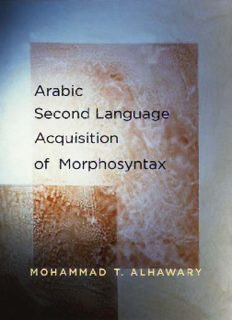
Arabic Second Language Acquisition of Morphosyntax PDF
Preview Arabic Second Language Acquisition of Morphosyntax
ARABIC SECOND LANGUAGE ACQUISITION OF MORPHOSYNTAX This page intentionally left blank ARABIC SECOND LANGUAGE ACQUISITION OF MORPHOSYNTAX MOHAMMAD T. ALHAWARY The University of Oklahoma Yale University Press New Haven and London Disclaimer: Some images in the printed version of this book are not available for inclusion in the eBook. Copyright © 2009 by Yale University. All rights reserved. This book may not be reproduced, in whole or in part, including illustrations, in any form (beyond that copying permitted by Sections 107 and 108 of the U.S. Copyright Law and except by reviewers for the public press), without written permission from the publishers. Publisher: Mary Jane Peluso Editorial Assistant: Elise Panza Project Editor: Timothy Shea Production Editor: Ann-Marie Imbornoni Production Controller: Karen Stickler Printed in the United States of America. ISBN: 978-0-300-14129-0 Library of Congress Control Number: 2008943948 A catalogue record for this book is available from the British Library. This paper meets the requirements of ANSI/NISO Z39.48-1992 (Permanence of Paper). 10 9 8 7 6 5 4 3 21 To Abu ‘Amr Ibn Al-‘Alaa’ (70-154 H./689-771 C.E.), the first Arab linguist who did field linguistics, eliciting data from the tribes of Arabia This page intentionally left blank Contents Preface xi Acknowledgments xiii Introduction xv Transliteration Symbols xix Abbreviations xxi 1. Description of Target Morphosyntactic Structures 1 1.1 Arabic Word Structure 1 1.1.1 Root and Base Form 1 1.1.2 Gender of Nouns and Adjectives 4 1.2 Nominal Inflectional Agreement Features 8 1.2.1 Agreement within NPs 8 1.3 Equational (Verbless) Sentence Structure 10 1.3.1 Past Tense of Equational (Verbless) Sentences 12 1.3.2 Negation of Equational (Verbless) Sentences 13 1.4 Verbal Inflectional Agreement Features 14 1.4.1 Verbal Agreement, Tense, and Null Subjects 14 1.4.2 Verbal Negation 16 1.5 Summary 19 2. Existing Arabic Second Language Acquisition Research 21 2.1 Contrastive and Error Analysis Studies 22 2.2 Performance/Developmental Studies 24 2.3 Developmental, Interlanguage, and Current Models 30 2.4 Second Language Acquisition and Universal Grammar 42 2.5 Summary 48 3. The Acquisition of Gender Agreement 49 3.1 Methods (Longitudinal Data) 50 3.1.1 Results of Nominal and Verbal Gender Agreement 54 yjii CONTENTS 3.1.1.1 Applying an Emergence Criterion 54 3.1.1.2 Applying a 90 Percent Correct Acquisition Criterion 58 3.1.1.3 Production of Gender Agreement in Non-Contexts 61 3.1.1.4 Noun-Adjective Word Order 64 3.1.2 Results of Demonstrative Gender Agreement 65 3.1.2.1 Applying an Emergence Criterion 66 3.1.2.2 Applying a 90 Percent Correct Acquisition Criterion 67 3.1.2.3 Production of Demonstrative Gender Agreement in Non-Contexts 73 3.2 Methods (Cross-Sectional Data) 73 3.2.1 Results of Verbal (Gender) Agreement 77 3.2.2 Results of Nominal (Gender) Agreement 79 3.2.2.1 Results of Natural versus Grammatical Gender Agreement 81 3.2.2.2 Rule Application of Nominal Agreement in Non-Contexts 82 3.2.2.3 Word Order of Nominal (Noun-Adjective) Agreement 84 3.2.3 Results of Nominal versus Verbal Agreement 86 3.2.4 Results of Demonstrative Gender Agreement 91 3.2.4.1 Rule Application of Demonstrative Gender Agreement in Non-Contexts 98 3.3 Summary 99 4. The Acqusition of Tense/Aspect and Verbal Agreement 101 4.1 Methods (Cross-Sectional Data) 102 4.2 Results 105 4.2.1 Tense (Narrative Tasks) 105 4.2.2 Verbal Agreement (Narrative Tasks) 108 4.2.3 Tense and Verbal Agreement (Random Task) 110 4.3 Summary 113 5. The Acquisition of Null Subjects 115 5.1 Methods (Cross-Sectional Data) 115 5.2 Results 118 5.2.1 Null Subjects Production 118 5.2.2 Null Subjects and Verbal Agreement Production 122 5.3 Summary 124 6. The Acquisition of Negation, Mood, and Case 125 6.1 Methods (Longitudinal Data) 127 6.1.1 Participants 127 6.1.2 Formal Classroom Input 128 CONTENTS IX 6.1.3 Data Collection and Coding 131 6.2 Results 131 6.2.1 Emergence Criterion 131 6.2.2 Negation Construction with la and the Indicative Mood 133 6.2.3 Negation Constructions with ma and lam and the Jussive Mood 134 6.2.4 Negation Construction with Ian and the Subjunctive Mood 136 6.2.5 ?an Construction and the Subjunctive Mood 139 6.2.6 Case within kāna and laysa Constructions 142 6.3 Summary 145 7. Theoretical Implications 147 7.1 L2 Learnability and Processability 147 7.2 LI Transfer and UG Access 153 7.3 Ultimate Attainment and Near Nativeness 157 7.4 The Split-INFL Hypothesis: More on L1 Transfer 163 7.5 Null Subjects and Setting of Parameters: More on UG Access and L1 Transfer 167 7.6 Summary and Areas of Future Research 170 8. Pedagogical and Applied Implications 173 8.1 Acquisition Tendencies of the Target Structures 173 8.1.1 Gender of Nouns 173 8.1.2 Gender of Adjectives 174 8.1.3 Gender of Demonstrative Pronouns 174 8.1.4 Verbal Agreement 175 8.1.5 Tense (Past and Present) 175 8.1.6 Negation 175 8.1.7 Case and Mood 176 8.2 Other Contributing Acquisition Factors 177 8.3 Who Can Benefit from the Findings 178 8.3.1 Syllabus Construction: Scheduling Learning Objectives 178 8.3.2 Arabic Foreign Language Pedagogy and Teacher Preparation 179 8.3.3 Foreign Language Proficiency Testing 179 8.4 Summary and Areas of Future Research 181 Notess 183 Glossary 199 Referencess 205 Index 215
Description: